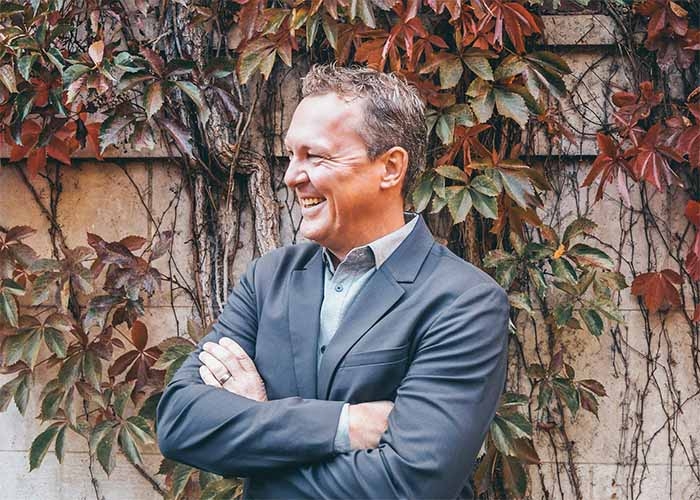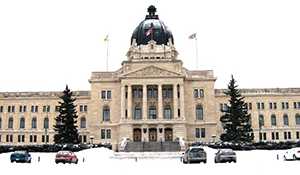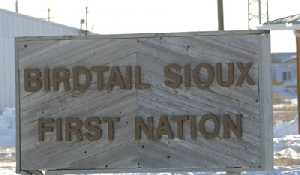Griffiths: building communities is most important job on earth
January 23, 2020, 4:33 am
Kevin Weedmark


Doug Griffiths, author of 13 Ways to Kill Your Community, is coming to Moosomin February 10 to speak about community development. Griffiths is a sought-after speaker with a lot of experience in development. The World-Spectator spoke with him last week. The full interview follows.
Can you explain to me how you got into the whole area of economic development?
I actually say it is not just economic development, it’s all-around community building. Just because of the way things have changed, anyone in the community that is trying to do economic development and not focusing on quality of life, and housing, and quality of education, and recreation services isn’t going to have much success with economic development.
But how did I get into it? I actually just shot my mouth off one too many times. Literally I lived in one town of about 1,200 people. I ranched and farmed about 20 miles down the road outside another community of about 1,200 people and I taught in the opposite direction half an hour. I taught middle school—junior high—and I just saw all three of the communities I was involved in were shrinking and dying and young people were leaving and businesses were closing and I started to shoot my mouth off for the need for rural development and for a rural community development strategy in Alberta and the next thing I knew I got elected to be the MLA there.
I wrote a rural community strategy for the province because it didn’t have one. I spent my 13 years as an MLA and some cabinet posts always focusing on community building and then I deliberately retired from politics on my own to go back to community building just because that was where my heart was.
How did 13 Ways get started? Did that start as a series of different presentations?
When I wrote the rural development strategy for the province of Alberta and had 72 recommendations that covered everything—health, education, community economic development, quality of life, youth, seniors, tourism, arts and culture—you name it, it was in the report. But with all the work I was doing with communities and all the meetings that I had, I realized that people were doing the opposite. They were doing things to sabotage the communities’ success. They are doing it unconsciously. They are not deliberately trying to kill their community. They just don’t realize the impact it’s having.
When I was a junior high teacher, I would go talk to high school students about how to be successful—you know, study hard, don’t do drugs, marry someone nice —and they would all say hey ‘yeah, that’s a great idea,’ but none of them changed what they were doing, so I actually changed my approach and I would go into the classroom and ask the students to describe to me what it would look like if they ruined their life, and they would say things like ‘well, I become a drug addict’ and would come up with a whole list of things and then I would say ‘great let’s say that is what you want to do. You want to become a drug addict. How would you start?’ And some of the high school kids would put up their hand and say ‘I would smoke a joint after school’ and two kids would turn red because that’s what they did yesterday. None of them wanted to a be a drug addict but that is how they would start.
Then it occurred to me that I am watching and telling all these communities ‘here are the 72 recommendations and this is how you need to approach it’ and I hear them say, ‘Yes we want to engage youth. We want to make sure they stay in the community and they are a part of it and have a reason to come home’ and I would listen to them, and as soon as they were done they would go to the coffee shop, community events, wedding dances everywhere and they would say ‘man, there is no hope in this community, there is no future, the businesses are closing, why would anybody open a business in this town? Only stupid kids stay here. All the smart ones go off to university and if you’re not smart enough you stay and farm. If you’re a hard worker, though, you go work in the oil patch because that is where you make a lot of money.’
I listened to them say they wanted to engage people and keep them there, but I listened to them and every word they said and every deed they did chased young people out of town.
They weren’t doing it deliberately but they didn’t realize everything that they did was the opposite of what they wanted, just like those high school students.
So I came up with a list of 10 things I saw communities doing ,and then it went to 15 and down to 12, then it eventually settled on 13, and I didn’t even realize until the guys were asking me if I would write the book, and they were like this should be a book “13 ways to kill your community,” and I realized oh that’s cool. So I wrote it all down. All those stories.
Are you’re basically a community development consultant now? Do you spend all of your time working with communities and agencies on this sort of thing?
I do three different things.
I speak, I do presentations at conferences, at provincial and state and national associations. I do about 40 a year, that is about all I can handle.
I also teach at the University of Alberta in their Rural Development Institute. I teach six classes I created to help municipal leaders learn to do better communication and strategic planning and plan for the future and to help them overcome some of those 13 ways.
And then I do consulting too for a few select clients that I think are ready and are prepared to change, so we do usually four at the most clients a year, that’s about all we can handle.
Can you give me an idea of what a success story looks like? Can you give me an example of a community that has been able to totally turn itself around?
No, but I can give you examples of success in progress, and the reason why I emphasize that is we actually put in our newsletters success in progress stories because there is no such thing as success in terms of you’ve done everything and everyone thinks you’re done.
One of the chapters in my book says don’t become complacent and just assume that you’re way ahead of the curve and that everything is good. Lose momentum and then you’re back behind the eight ball. So I never say there is a success story, there is only success in progress. Even when a community overcomes one challenge, there are always more challenges right around the corner. It’s easy to focus on the negative and that is right back to the heart of 13 ways, focusing on what’s wrong that have had to turn it around.
There are lots of success in progress stories all related to specific things. Fort St. John, B.C. were going to put in water meters in the homes. They did it and they had such massive pushback from people who said ‘why should we have to pay for water? This is just another tax on us.’ The mayor came up with a brilliant idea to put on the water bills the current charge—everyone paid the same rate and then to show them how much water they were using based on the water meter and what their rate would be based on their use so they could see what they were currently paying and see what they would be paying based on their use. They also put data on the bill that showed the average monthly use so they would know how they fit in the community, and after a year they found people were looking at the bill and saying ‘Why do we use so much water? Why do we use more than everybody else?’ and they started to manage their water use better. The entire community, not just individual households, brought down their water consumption and managed it better. Everyone had looked and realized ‘hey, if we go to this water system based on use my bill will go down’ because everyone in the community is using less water and ta-da they overcame it.
Now they still have other challenges. Every community has challenges. There is no community where you look and say everything is perfect. But everyone is finding ways to overcome challenges and that’s why there is success in progress.
Wasaga Beach is another one. They are in Ontario and if you know the story of Wasaga Beach it is like the largest fresh water beach in the world. That place in the seventies was packed. You could barely find a spot on the beach to relax. It was the most popular place in Ontario. It was incredible and then it started to go in decline.
It got run down like a lot of places did sort of in the late seventies and early eighties and that led to decline. Well they weren’t sure what the decline was but people stopped coming. The numbers went down, the economy suffered which meant the businesses didn’t do maintenance and upkeep which chased more people away and then it just cycled down until in the mid nineties it was devastation.
In the early 2000’s they had a fire that took out an entire block and the headline read “Is this the end of Wasaga Beach?” Citizens got upset. They said this is enough and citizens got together and raised some money to design what Wasaga Beach could look like with the right investment. How it should design itself for the future and then they raised money to paint and they started painting buildings and started drawing in these little micro businesses, and they looked like fishing shacks but they were yellow, blue and colorful and bright and they started to paint the sidewalks and they started to brighten the whole place up, and the headline one year after that, only two years after that massive fire, was “Wasaga Beach the success story of the decade.”
And now it is packed down there and it is back to being the place to go to if you are in the Great Lakes region.
It was citizen owned and it wasn’t the government that fixed it, the provincial government or the municipal government, although they had municipal leaders that bought into the plan and the strategy and supported it and accepted the redesign for Wasaga Beach at that time. They are reaping the benefits of that two years worth of energy from volunteers.
What is the number one thing that makes a difference between a community that is moving in the right direction and one that is sliding back?
There are a lot of things that make a difference, but number one is attitude. I know it probably sounds really trite, but I go to communities and I hear people say ‘I believe we can do this’ and they’re willing to work hard, and yes there are always negative people in the community, but as long as there are enough positive people saying ‘we are going to do this and are willing to work hard,’ that is the number one thing that will turn communities around.
But I have been to communities with millions of dollars available to them to work on stuff and if the community says ‘no, this won’t work, it is never going to happen, it can’t be done,’ they somehow find a way to prove themselves right. Attitude is everything.
What is the main point you are going to try to get across to the communities out here when you come out to southeast Saskatchewan?
Well I have a couple different messages and there are a couple different presentations that I’m going to be doing, but I’m going to be emphasizing at it’s core that the world is changing and there are two perspectives right now in our rural communities all around North America, revolutions or renaissance.
Those that are focused on a revolution, their mindset is that wrong has been done and they are going to reclaim the past.
They are going to reinvigorate their economy the way it was in the seventies and all will be well, but they’re going to fail because the world is changing dramatically and instead of focusing on the past and reclaiming old glories and old economies, there are a myriad of changes and new opportunities out there, where there are young people and old people and everyone in between that are looking for real authentic communities—not the ones of yesterday but the ones of tomorrow—and if your community is ready to embrace them and build your community to attract those new people, then you’ll have a renaissance, and that’s the choice communities have—revolution or renaissance—and I hope they choose renaissance.
I read in either your book or one of your columns the role of competition in small town, using the example of where there was one major store like a grocery store or a hardware store as opposed to two and the difference that made in the number of people shopping within the community.
Yes, competition is critical and unfortunately there is a mindset in a lot of communities that they are going to try and stay the way they are and that competition is a bad thing, yet we know that competition is good for the economy.
It’s actually good for all of the business owners, too. Before Christmas, I had to go meet with a business owner because she was upset with her community. It was a Subway and an Esso gas station on the highway on a major, major highway between two big urban centres. It was about two hours between them and it was right in the middle so she would get some traffic that would stop and eat at her Subway, and the community wanted to attract a Dairy Queen and an A&W and she was fighting them because she said ‘this will kill my business. I mean I’m doing okay right now but if I have to share I get only one of every three clients stopping, then I’ll go broke.’
The town asked me if I could help so I went down and she agreed to travel with me for a few hours and we toured around and I showed her. First we did a highway count of how many vehicles on average. She agreed it was about two of every hundred that pulled off the highway to the gas station and her restaurant. And then we went to a few other examples, and I didn’t get that far, but I showed her gasoline alley in Red Deer which started off as a fast food place and a gas station and now it is almost a city to itself, and I pointed out to her that if you have two more restaurants and another gas station it will get more people to stop.
I asked ‘do you ever drive with your kids? Everyone wants something different and not everybody wants Subway all the time. If there are multiple things to pick from you won’t get two people out of every 100 stopping, you get eight out of every 100 stopping and that will actually double your business rather than cut it into a third.’ It took some examples and some discussion and she agreed and now she is supportive.
She said “You know what I’m going to open another gas station or I may help open another franchise,’ because she realizes the more businesses that are there the more likely you are going to attract more customers.
That’s why golf courses advertise together. In PEI you don’t have three golf courses competing against each other, they put all their stuff in one brochure and someone can do a three course tour in a week.
In lots of places it’s why they have multiple car dealerships all along located all at the same place. They do it on purpose because they are not competing, they just know they are going to draw more clients.
The St. Albert Trail on the way out to St. Albert is lined with furniture stores and if you said ‘Oh I’m not locating there because there’s too much competition’ and went to the other side of Edmonton to relocate, nobody is coming to see you. They are going down there where you can go door to door and shop.
There was one place in Saskatchewan that said, when you talk about brew pubs, ‘well we are saturated. I mean we have two brew pubs. I don’t know if we need a third.
You know what, if you had six you could be the next Nashville. Nashville didn’t grow to be Nashville because they only allowed one live music place.
They encouraged 20 live music places and that is how they got a reputation and that is what draws more people in.
Those places aren’t going broke because there are so many—they have more clients because they have so many.
Competition is always good. There is better price, quality, selection and service as well as atmosphere and other elements and it draws people in instead of having them say ‘I only have one choice. I’m going to go somewhere where I have multiple choices,’ and then the money leaves town.
What have you learned in this process of going to communities and talking to people all over about these same issues?
Number one, we all have the same issues. I realized that a lot of us are afraid to talk about the issues in our communities because we feel alone, we’re scared to talk about them because we are embarrassed, but the more we talk about them the more we realize everyone has these issues.
I’ve been from Alabama to Alaska and everywhere in between and there is no place I’ve been that doesn’t have issues that need to be addressed that it has in common with other communities. And I’ve also found there is no place I’ve been that hasn’t found a solution to something. There is not a single issue I have identified yet that hasn’t been resolved by someone.
So we all have these same problems and somewhere out there everyone has found a solution, and if we just started talking we could fix these things and make them better.
What format is your presentation?
It makes people laugh, makes people angry, makes people cry, and then I wrap it up. Then I’ll take any questions as long as there is time. I’m always happy to talk about some issues and answer some questions.
Do you have fun doing this?
Yes I do. I have the greatest job on earth because personally I think building communities is the single most important job on earth.
I spent 13 years in provincial politics and I heard people say things like ‘oh do it for the children, do it for the families,’ and I realized children have different needs, families have different desires, but if we just focused all our energy on building strong communities, then leadership can be successful and families can be successful and they can take care of each other. Businesses are profitable.
Building communities to me is just the foundation of building a strong provinces and a strong nation. It is the most important job on earth.



































